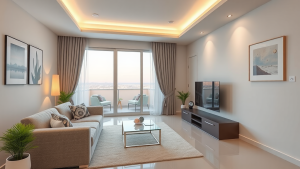Key steps to check construction quality before finalizing your purchase
Purchasing property, especially one under construction, can be a thrilling yet daunting process. To ensure you make a wise investment, it’s essential to check the construction quality before finalizing your purchase. Here are key steps that can guide you through this critical evaluation process.
Research the developer
Before diving into the specifics of your desired property, it’s important to investigate the developer’s reputation. Look for feedback from previous buyers and see how long the developer has been in the industry. A developer with a solid track record is more likely to deliver quality construction.
Inspect the construction site
Visiting the construction site in person can provide valuable insights. Here’s what to look for:
- Materials Used: Check if high-quality materials are being used. Ask about the types of cement, bricks, and other structural elements.
- Workmanship: Observe the workers on site. Skilled and experienced labor typically results in better construction quality.
- Work Progression: Take note of the construction timeline. Delays can sometimes indicate issues with quality or management.
Examine building plans
Do not skip reviewing the building plans and architectural designs. Make sure they comply with local laws and regulations. Understanding the layout and intended design can help you assess whether the final product will meet your expectations.
Engage a third-party inspector
Hiring a professional inspector often pays off. These experts can identify issues you might overlook. They will check for:
- Structural Integrity: This includes examining foundations and walls to ensure stability.
- Systems Quality: Inspect electrical, plumbing, and HVAC systems to confirm they meet safety standards.
- Finishing Works: Look at the quality of the paintwork, flooring, and installations. Details matter for long-term satisfaction.
Ask for quality certifications
Request any quality certifications the builder may have. Documents such as ISO certifications or green building certifications can assure you of the construction’s quality. These certifications often show that the builder adheres to reputable standards in construction practices.
Check compliance with local regulations
Ensure that the project complies with local building codes and laws. This might include zoning laws, safety requirements, and environmental regulations. A property built without the necessary permissions may lead to future complications.
Consult with neighbors
Talk to other residents or potential neighbors in the area. Their experiences can provide you with insights regarding the quality of construction and how the builder handles post-purchase issues. This grassroots-style insight can reveal the builder’s commitment to ongoing maintenance and customer service.
Review warranty policies
Check the warranty offered by the builder. A robust warranty policy can signify confidence in the construction quality. Understand what it covers, how long it lasts, and the process for claiming any repairs or issues post-purchase.
Assess accessibility to services
While evaluating the property, think about its accessibility to essential services such as schools, hospitals, and public transportation. This may not directly relate to construction quality, but overall property value and quality of life depend on infrastructure and convenience.
Take your time
Don’t rush into closing the deal. Take your time through each of these steps, gathering all necessary information to make an educated decision. Checking construction quality is a vital part of securing a successful investment.
By following these steps diligently, you can effectively evaluate the construction quality of the property before making your purchase. Remember, being proactive can save you time, money, and frustration down the line.
Common red flags in construction quality you should look out for
When considering the purchase of a new home or property, ensuring construction quality is vital. Even small issues can snowball into significant problems over time. Here are some common red flags you should look out for before finalizing your purchase.
Visible cracks and structural issues
One of the first signs of poor construction quality is the presence of visible cracks. These can be found in walls, ceilings, or foundations. While small cracks might seem normal, larger fissures could indicate severe structural issues. Keep an eye out for:
- Diagonal cracks in corners where walls meet.
- Vertical cracks wider than 1/8 inch.
- Cracks in the foundation that allow water seepage.
Poor quality materials
The materials used in construction significantly influence the longevity and quality of a building. If you notice subpar materials, this can be a big red flag. Pay attention to:
- Low-grade insulation, which affects energy efficiency.
- Flimsy drywall or cheap flooring options.
- Poorly constructed roofing that might not withstand weather conditions.
Inconsistent workmanship
Take a closer look at the workmanship throughout the site. Inconsistencies can indicate rushed or unqualified labor. Some signs include:
- Uneven surfaces or poorly fitted fixtures.
- Mismatched paint or finishes in various areas.
- Doors and windows that do not open or close smoothly.
Water damage and mold
Water damage can be insidious and suggests that there may be leaks or inadequate drainage systems. Look for:
- Stains on walls or ceilings.
- Visible mold on surfaces in bathrooms or basements.
- Odors that suggest moisture problems.
Unpermitted additions or modifications
Any unpermitted construction can be a massive issue. Not only might this affect your insurance, but it can raise safety concerns. Check for:
- Construction projects that lack proper documentation.
- Modifications made without the necessary inspections.
- Alterations to the original design that could compromise the integrity of the structure.
Poor site drainage
Proper drainage is essential to a building’s longevity. If water accumulates near the foundation or in the yard, it could lead to severe problems. Watch for:
- Pooling water that does not drain quickly.
- Soil erosion around the property.
- Water marks on walls or foundations.
Hvac and electrical issues
Heating, ventilation, and air conditioning (HVAC) systems should be installed correctly to ensure comfort and safety. Electrical systems must also be sound to prevent hazards. Red flags might include:
- Inconsistent temperature regulation in different rooms.
- Unprofessional or tangled wiring in electrical panels.
- Old or malfunctioning appliances and fixtures.
Sound and noise issues
Excessive noise can indicate poor insulation or gaps in walls, which can affect both comfort and efficiency. If you hear noises from outside or from neighboring units, consider:
- Thin walls that don’t block sound.
- Unsealed windows that let in drafts and external sounds.
- Inconsistent noise levels that suggest poor construction techniques.
Being vigilant about these common red flags in construction quality can save you from headaches down the line. Always take your time during the inspection process and consider hiring a professional to conduct a thorough evaluation. This proactive step can help ensure you make a sound investment in your future home.
Ensuring the quality of construction before finalizing your purchase is essential for making a wise investment. By following the key steps mentioned earlier, such as conducting thorough inspections, reviewing documentation, and researching the builder’s reputation, you’ll be better equipped to make informed decisions. Remember that quality should not be an afterthought but a priority in your home buying journey.
Moreover, being aware of common red flags can save you from potential pitfalls. Cracks in walls, poor drainage, or uneven flooring are signs that don’t just hint at aesthetic issues—they can signify deeper structural concerns. Taking the time to investigate these issues can help you avoid costly repairs down the line.
Ultimately, the key to purchasing a property you will be happy with for years to come lies in due diligence. Engaging professional inspectors can offer you additional peace of mind, giving you an expert’s eye on the construction quality. Additionally, seeking feedback from current residents of the area can provide insights you might not find elsewhere.
Being proactive and cautious in your approach will ensure that you’re not just buying a house, but a safe and well-built home. With the right preparation and knowledge, you can confidently step into your new space, secure in the quality of your investment. Always keep quality at the forefront of your decision-making process, and you will be well on your way to making not only a successful purchase but a happy home.
16% off – spacious 4 bedroom town house for sale in al kawther Hurghada under 200k — properties for british surfers
21% cheaper – contemporary 2 bedroom apartment for sale in al kawther Hurghada under 125k — affordable homes for russian traders












